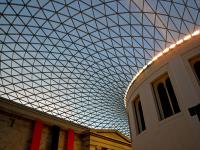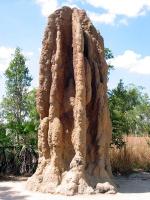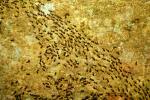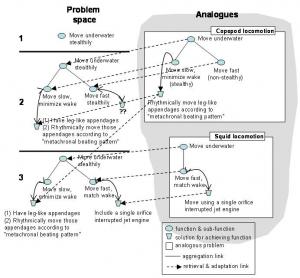The Bio-Inspired Design Landscape
 Interest in bio-inspired design is accelerating. Biomimicry is regularly on the agenda of high profiles events such as Bioneers, Green Build and UN conferences ranging from climate change to biodiversity. BIONIS (the Biomimetics Network for Industrial Sustainability) has been actively "promot[ing] the application of Biomimetics (Design Inspired by Nature) in products and services and its use in education and training' since 2002. The journals Bioinspiration & Biomimetics and the Journal of Bionic Engineering are dedicated to the field. A steadily growing number of courses are available from The Biomimicry Institute and universities, including the Biomimicry Professional Certification Program.
Interest in bio-inspired design is accelerating. Biomimicry is regularly on the agenda of high profiles events such as Bioneers, Green Build and UN conferences ranging from climate change to biodiversity. BIONIS (the Biomimetics Network for Industrial Sustainability) has been actively "promot[ing] the application of Biomimetics (Design Inspired by Nature) in products and services and its use in education and training' since 2002. The journals Bioinspiration & Biomimetics and the Journal of Bionic Engineering are dedicated to the field. A steadily growing number of courses are available from The Biomimicry Institute and universities, including the Biomimicry Professional Certification Program.
Biologically-inspired patents in the US and China are showing exponential growth (Patented Biologically-inspired Technological Innovations: A Twenty Year View, Bonser). The Third International Conference of Bionic Engineering is being held on September 14-16/2010, in Zhuhai, China. More important, significant biologically-inspired innovations are now available in the marketplace, including the PAX Streamlining Principle, Lotusan® self-cleaning paint, PureBond® water-resistant adhesives, Mirasol® structural color displays and Regen Energy's EnvironGrid swarm-logic power controllers.
Application Sectors
The following sectors are briefly reviewed:
followed by a discussion of the role of cognition in bio-inspired design.
Architecture
Architecture has come to the field of modern biomimetics relatively recently compared with engineering and medicine, but the profession’s adoption appears to be accelerating rapidly. Computational capacity, development of sophisticated sensors and building information systems, and new materials and methods are changing this tradition-based profession.
Technological advances in form-making tools now available to nearly any practitioner also explain this rapid adoption. Powerful parametric software programs like Rhino and Grasshopper have enabled designers to form organic shapes within the constraints of digital building plans and to test stresses on these shapes. Laser sintering and contour crafting devices now allow rapid prototyping. These tools have enabled an evolving paradigm shift in the way that designers approach the problems of building design. Many designs now proceed from the complex formulation of constraints and the custom optimization of structural elements rather than the more traditional aggregation of standard manufactured parts.
 A good example of this is the Great Court roof of the British Museum by Sir Norman Foster and Partners. A torroid shaped glass roof was constructed over the court and links the central cylinder of the old library with the rectangular perimeter of the court. The roof design was a collaboration of engineers, architects and a mathematician, and its final form is the result of the forces acting on the existing historical buildings and the roof, rather than a concept of the individual designer retroactively engineered to work.
A good example of this is the Great Court roof of the British Museum by Sir Norman Foster and Partners. A torroid shaped glass roof was constructed over the court and links the central cylinder of the old library with the rectangular perimeter of the court. The roof design was a collaboration of engineers, architects and a mathematician, and its final form is the result of the forces acting on the existing historical buildings and the roof, rather than a concept of the individual designer retroactively engineered to work.
More architects are also discovering the rich treasure trove of inspiration nature offers. In the best cases of such adoption, the translations go beyond mere form and metaphor to include functional advantages. The so-called Water Cube or Aquatics Center at the Beijing Olympics is an innovative use of both form and materials. Its famous “water bubble” frame is based on a least surface formulation called the Weir Phelan model, and the ETFE (Ethylene tetrafluoroethylene) stretched over this frame is lightweight, relatively durable and efficient.
 The drive to save energy within buildings is also prompting designers to capitalize on thermodynamic forces, something natural organisms have been doing for billions of years. The pioneering work of Mick Pearce is a case in point. His Eastgate Building in Harare, Zimbabwe, and Council House Two building in Melbourne, Australia, are examples of nature-inspired strategies for passive climate control in buildings. The Eastgate’s cooling mechanisms were inspired by the structure of an African termite mound (http://www.greenbiz.com/blog/2009/09/02/how-termites-inspired-mick-pearces-green-buildings).
The drive to save energy within buildings is also prompting designers to capitalize on thermodynamic forces, something natural organisms have been doing for billions of years. The pioneering work of Mick Pearce is a case in point. His Eastgate Building in Harare, Zimbabwe, and Council House Two building in Melbourne, Australia, are examples of nature-inspired strategies for passive climate control in buildings. The Eastgate’s cooling mechanisms were inspired by the structure of an African termite mound (http://www.greenbiz.com/blog/2009/09/02/how-termites-inspired-mick-pearces-green-buildings).
Historical examples of bio-inspired architecture include the Eiffel Tower, 1889, and the Crystal Palace, 1851 (http://www.greenbiz.com/blog/2010/03/03/it-worth-looking-nature-profit) and the work of Frei Otto and the engineer Heinz Isler (http://www.greenbiz.com/blog/2009/07/22/structure-old-shell-game). Although Isler’s intent was not to mimic nature but to push the bounds of structural performance, he realized he could quickly source solutions by earnest observation of natural phenomena.
Future trends in the profession are likely to include many that are bio-inspired: increasingly sophisticated feedback loops for environmental controls, information-embedded materials that obviate the need for active energy use, and systems design are all examples (http://www.greenbiz.com/blog/2010/06/16/will-synthetic-biology-lead-truly-living-buildings). Finally, the wider cross-disciplinary approach beginning in other fields has also come tentatively to architecture. This offers exciting possibilities for collaboration and innovation.
Tom McKeag
California College of the Arts and UC Berkeley
Founder and President of BioDreamMachine
Industrial Design
Over-simplifying it, we could say that design as a human activity is mainly our conscious action to modify our environment. If we consider our environment as our context, then design affects our context at different levels and in different scales. From small to big (micro to macro) we can define a local, regional, national and global context. Within this same logic from small to big, our man made world is enriched by diverse design disciplines which are closely interrelated but operate on different levels of complexity and scale, such as Industrial Design, Interior Design, Architecture, and Urban Planning. In the smaller hand-scale or human scale, we have Product Design or Product Design Engineering.
Industrial Design has been greatly influenced by nature. Examples include diverse movements that range from the “Aerodinamism”, “Styling” and “Organic Design” styles of the mid-twentieth century, to today’s “Blobjects” (Holt, 2005) as popularized by contemporary design icons such as Phillip Starck, Mark Newson, Ross Lovegrove or Karim Rashid, among many others. It is not surprising, then, that Industrial Design education, “the teaching of a horizontal and cross-discipline profession” (Papanek, 1984) has also incorporated bio-inspired studies for more than thirty years.
The “industrial” aspect of Industrial Design has a strong link with engineering design and technology. In this area, diverse bio-inspired approaches have generated some of the most important inventions in the last three centuries of human history. Fields of research such as “biomechanics”, “bio-engineering”, “bionics”, “robotics”, and “biomimetics” had their origin mainly during the mid twentieth century and are today widely explored fields.
More recent bio-design is what some researchers have defined as “biophilic design“ (Kellert, Heerwagen & Maador, 2008) to describe an “innovative approach that emphasizes the necessity of maintaining, enhancing and restoring the beneficial experience of nature in the built environment.” Biophilic design has its origin in the term “biophilia” coined by scientist E.O. Wilson in 1984, which is the “inherent human inclination to affiliate with natural systems and processes, especially life and life-like features of the non-human environment”. This approach is based on scientific evidence that contact with nature has strong positive effects in human beings, in terms of healing from diseases, productivity at work, etc. As such, it tries to bring nature and natural elements back into the built environment. This in turn promotes the use of bio-inspired design within the manmade dwellings, to enhance human well-being by connecting us to nature, or to elements which remind us of nature.
A visual summary of some of the different examples of bio-inspired design mentioned above is found in the following figure. The examples are classified in terms of form, function and process or system from nature, based on the levels of “biomimicry” as proposed by Janine Benyus (1997).
 In the upper area we see several examples of “Biomorphism”, or forms inspired in nature. They range from pieces from the arts and crafts and art nouveau period in the early 1900’s to the organic furniture and spaces of the 1950’s, and finally to some contemporary “blobjects”.
In the upper area we see several examples of “Biomorphism”, or forms inspired in nature. They range from pieces from the arts and crafts and art nouveau period in the early 1900’s to the organic furniture and spaces of the 1950’s, and finally to some contemporary “blobjects”.
The middle band shows function inspired by nature, which usually has a strong technological focus. Many early inventions, such as barbed wire or cat eyes are bio-inspired. More recently, the invention on “Velcro” and even the famous ”lotus effect” are also bio-inspired. Currently in the market we can find many bio-inspired products, such as the bionic car concept inspired by the boxfish, the swimming suits inspired in shark skin, protective devices inspired in armadillos and pillbugs, and many others.
Finally, the lower band illustrates bio-inspired design at the level of processes or systems, probably one of the most difficult yet important aspect. Because of the scale of bio-inspired systems thinking, some theories of urbanism, architecture and landscape design have also been included in the graph, such as the metabolic and symbiotic architecture, eco-cities and others.
Two of the most relevant examples of contemporary imitation of nature which are strongly linked to Industrial Design and operate at a systems level are ‘Industrial Ecology’ and ‘Cradle to Cradle’. The term Industrial Ecology was coined in 1989 (Frosch, R & Gallopoulos, N) and widely divulged by Graedel & Allenby (1995). This new systems-based multidisciplinary relationship between industry and ecology that proposes analogies between natural systems (ecosystems) and human-made systems related to industrial production. Two of the most important analogies of Industrial Ecology with nature are in terms of ‘metabolisms’ and ‘symbiosis’. Industrial metabolisms are related to the study of flows and cycles of materials and energy in industry, while industrial symbiosis describes the way in which different ‘industrial organisms’ can co-exist in an ‘industrial ecosystem’. The best known example of Industrial Ecology is the Kalundborg Eco-Industrial Park, located in Denmark, where diverse industries conveniently located nearby share their energy and materials such that wastes from one industry become resources for the other.
The ‘Cradle to Cradle’ theory developed by McDonough and Braungart (2002) proposes closed-loop life-cycles inspired by nature for architectural and industrial production, as opposed to the traditional linear life-cycle previously known as ‘Cradle to Grave’. Our current efforts for ‘recycling’ diverse mixed wastes of industrial products and urban construction is better described as a ‘down-cycling’ process and ‘end-of-the-pipe solution’ in which the materials lose their properties. Cradle to Cradle proposes design strategies from the ‘beginning-of-the-pipe’ in which products are intentionally designed to be ‘up-cycled’ in closed-loop systems. In nature nothing becomes waste and everything becomes part of the food chain. Thus, Cradle to Cradle can be understood as a type of bio-inspired design at the systems level, in which designers, architects and urban planners imitate how ecosystems work in nature.
Associate Professor - Industrial Design
University of Canberra, Australia
Materials
The list of materials inspired by biology is long and diverse, ranging from the ubiquitous Velcro to Lotusan paint, the Fastskin swimsuit, dry adhesive 'gecko' tape and waterproof adhesives inspired by mussels. A search on Google for 'biomimetic material' results in over a million hits, including a pointer to The Biomimetic Materials Laboratory at the McGill University Faculty of Engineering.
 The recently published Bulletproof Feathers: How Science Uses Nature's Secrets to Design Cutting-Edge Technology includes a chapter by Prof. Julian Vincent on New Materials and Natural Design. Although biological and engineered materials overlap in their functional characteristics, they differ greatly in their constituents, manufacture, structure, usage characteristics and disposal. For example, water is usually avoided in most engineered materials since it causes degradation. In biological materials, water is a key reaction medium and often a critical component. Although water may have a small molecular size, it 'lifts above its weight class' as a plasticizer, lubricant and structural component. It is also a crucial component in 'assembly zones' that organize the way biological polymers interact, making sure that hydrophobic areas can identify and stick to each other.
The recently published Bulletproof Feathers: How Science Uses Nature's Secrets to Design Cutting-Edge Technology includes a chapter by Prof. Julian Vincent on New Materials and Natural Design. Although biological and engineered materials overlap in their functional characteristics, they differ greatly in their constituents, manufacture, structure, usage characteristics and disposal. For example, water is usually avoided in most engineered materials since it causes degradation. In biological materials, water is a key reaction medium and often a critical component. Although water may have a small molecular size, it 'lifts above its weight class' as a plasticizer, lubricant and structural component. It is also a crucial component in 'assembly zones' that organize the way biological polymers interact, making sure that hydrophobic areas can identify and stick to each other.
Vincent describes how proteins constructed from a pool of 20 different amino acids can have a wide range of properties, from the relatively flexible collagen and elastin to dragline silk that is stronger than steel yet produced at ambient temperatures and pressures. Polysaccharides, the other major biological polymer, are found in gels and space fillers as well as stiff fibers such as cellulose, the raw material for some of our first plastics. He goes on to describe the key principles of other materials such as soft and stiff composites, ceramics and biomimetic skins.
Vincent repeatedly emphasizes the importance of structure and hierarchy in biological materials. Whereas engineered tends to focus on a narrow range of scale, hierarchy "is the only way in which biological organisms can make large structures, and is therefore intrinsic." In biology, hierarchy influences all aspects of materials from their construction to recycling and strongly determines characteristics such as stiffness and strength. Understanding hierarchy and scale can point us to new ways of using existing manufacturing technologies that are less resource intensive.
Vincent's chapter closes with a discussion of technology transfer and a comparison of biological vs. technological 'solution pathways'. His BioTRIZ team estimates that we manipulate energy and substance to solve 85 percent of our materials processing problems, with energy making up the largest component at 70 percent. In biological systems, structure at 20 percent and information at 15 percent appear to be used most frequently, with energy the least used at five percent (see Biomimetics: its practice and theory for more details as well as A Comparison of Biological and Technological Systems in the November 2008 BioInspired! Newsletter).
In contrast to materials that can theoretically be recycled indefinitely, the quality of energy degrades continuously. Similarly, alternatives can be found for most materials, but we still rely largely on solar radiation for our energy. Understanding the principles underlying biological materials can help us develop technologies that, like nature, minimize energy consumption.
Norbert Hoeller
Editor, BioInspired! Newsletter
Systems and Processes
Much of our modern technology involves complex systems, which are characterized by a large number of interacting parts. In many cases, these interactions are so difficult to model that designers have only a dim idea what will happen when the parts are put together. The escalating cost of building new generations of aircraft is a manifestation of this problem. In other cases, the system is so complex that central management may be difficult (if not impossible) or incredibly inefficient. Someone accessing this site from, say China, is connecting through a series of internet nodes embedded in a fantastically large and fluid network. How does one manage this traffic easily given the size, scale and variation of traffic in the global net?
Our ability to build increasingly complex systems that may defy our design and management skill has led engineers and scientists to examine how complex natural systems are organized. In many cases, these systems perform highly elaborate and coordinated behaviors without an apparent central governing authority. Embryos develop into organisms, loosely aggregated collections of semi-autonomous cells efficiently distribute materials, and colonies of insects have a highly ordered and efficient system for maintaining their living conditions.
Across a range of systems, the key principles of complex system organization and management are that local agents (cells, organisms, species) transmit information about both the state of the system and their individual actions, by modifying the local environment. This produces a one-to-many communication system that has two important consequences:
- Agents can act on this local information using very simple rules (a second principle) in an appropriate way without the need for central coordination.
- Local actions with a desirable outcome are reinforcing by changing the state of the system in a way that is communicated to local agents (a third principle), which can then act on this information.
Slime molds utilize these principles to construct highly elaborate and efficient transport networks. The organisms are actually aggregates: a multinucleated mass of tissue that is not differentiated into discrete cells except in certain circumstances. They have no nervous system, much less a brain. Nonetheless, these primitive organisms can produce highly efficient transportation networks. When the slime mold Physarium is placed in an environment with resources mimicking the location of transit stations in and around Tokyo, the resulting pattern of connections was more efficient than the current subway design. The network produced the same minimal distances between any two points but with a smaller overall network. The investigators were able to model this by positing that connections between two points respond to the flux through them, so they grow when material moves through them efficiently, but are pruned otherwise. Obviously, one would not want to construct a network in this way, but it provides a design template that is potentially better than other methods. Since information can also be said to “flow” it may help design better ways to connect sensor networks as well.
 Groups of organisms also self-organize in ways to produce impressively efficient performance, and scientists have adapted those rules in a variety of ways. AntNet directs internet traffic based on the behavior of ant colonies, which find the best routes to resources so that the colony enjoys the greatest rate of provisioning. Real ants communicate by chemical trails that let other ants know a possible route. If more ants take the trail (because say, it is the fastest), then the pheromone concentration increases and attracts more ants until such time as it becomes too highly trafficked, in which case ants will end up switching to another trail. AntNet uses virtual ants in an equivalent manner - these virtual ants produce signals that modify the state of the network to recruit more traffic on given route, so quick routes become noticed and preferred.
Groups of organisms also self-organize in ways to produce impressively efficient performance, and scientists have adapted those rules in a variety of ways. AntNet directs internet traffic based on the behavior of ant colonies, which find the best routes to resources so that the colony enjoys the greatest rate of provisioning. Real ants communicate by chemical trails that let other ants know a possible route. If more ants take the trail (because say, it is the fastest), then the pheromone concentration increases and attracts more ants until such time as it becomes too highly trafficked, in which case ants will end up switching to another trail. AntNet uses virtual ants in an equivalent manner - these virtual ants produce signals that modify the state of the network to recruit more traffic on given route, so quick routes become noticed and preferred.
 Similarly, new algorithms that direct queries to server networks hosting multiple internet sites (such as Amazon or other commerce or banking services) use a virtual equivalent of bee communication during foraging. A query coming in to the server bank from a given application is “advertised”, just as a bee advertises the location of its flower patch to its hive mates. The goal of a server is to minimize its idle time (much like the goal of the bees) so servers switch their attention to applications with many queries and small wait times. In both these cases, the biologically inspired approach is better than existing methods, particularly for rapidly changing conditions - adaptability and robustness are a hall mark of organic self-organization.
Similarly, new algorithms that direct queries to server networks hosting multiple internet sites (such as Amazon or other commerce or banking services) use a virtual equivalent of bee communication during foraging. A query coming in to the server bank from a given application is “advertised”, just as a bee advertises the location of its flower patch to its hive mates. The goal of a server is to minimize its idle time (much like the goal of the bees) so servers switch their attention to applications with many queries and small wait times. In both these cases, the biologically inspired approach is better than existing methods, particularly for rapidly changing conditions - adaptability and robustness are a hall mark of organic self-organization.
The critical distinction is that traditional ways to solve these problems are backwards looking: the appropriate solution is derived using prior information. Biological strategies develop rules that respond to changes in the state of the environment but also change its state. Variations of these principles have been used to route delivery trucks or direct factory manufacturing.
Despite some successes, biologically inspired solutions to problems in complex systems seem less numerous than examples from materials or biomechanics, for reasons that are not clear. It may be that there are fewer instances of the necessary parallelisms between natural and human. Perhaps it is no accident that the most successful applications concern transport or distribution, both of which have some obvious physical correlates. It may be that the constraints in natural systems do not permit easy transference. Ant or bee colonies consist of numerous individuals strongly united by a single goal, whereas collections of humans do not always display this level of allegiance.
Perhaps we are limited by a failure to abstract principles creatively. A number of large companies are trying to circumvent organizational hierarchies by emphasizing one-to-many communication, local task recruitment and changes in environmental state based on the resulting decisions. Hopefully, increasing our ability to understand and teach the cognitive processes that underlie our ability to transfer principles from one field to another will accelerate our ability to learn from biological systems. Given the complexity and success of self-organization in biology, it is likely we will find additional solutions if we are clever.
Marc Weissburg
Center for Biologically Inspired Design
Georgia Institute of Technology
Cognition in Biologically Inspired Design
The Biomimicry Guild has developed a number of methods to help designers, including the original biomimicry methodology and Design Spiral and the new Biomimicry Approach (Draft: 2009). A complementary approach is to study how designers design. How do designers behave, think, perceive, act, communicate and learn when designing? What knowledge, experience, styles, biases and values do they bring to a situation? What kinds of internal and external representations and models do they use and construct? How is designers’ work situated in the physical, social, cultural and information worlds around them? How does designing interact with other processes of an artifact’s development such as prototyping, realization, use and evolution? How do designers collaborate in teams and organizations, across space and time?
For four years, Georgia Tech’s Design & Intelligence Laboratory (http://www.dilab.gatech.edu/) and Center for Biologically Inspired Design (http://www.cbid.gatech.edu/) have been exploring these questions. Our methodology has been to conduct in situ observations of interdisciplinary teams of designers, develop cognitively consistent information-processing models of biologically inspired design, compare the models with design case studies, build computational tools for supporting education, and evaluate the effectiveness of these tools.
 Preliminary findings about some of the processes involved in biologically inspired design can be organized into six categories:
Preliminary findings about some of the processes involved in biologically inspired design can be organized into six categories:
- Co-evolution of problems and solutions, particularly where the problem space is poorly defined.
- Compound analogies that incorporate the different levels and aspects of problem decomposition (the diagram to the right relates to the Eye in the Sea design project, described in the November 2008 issue of the BioInspired! newsletter).
- Problem-driven and solution-based design processes, similar to the ‘challenge to biology’ and ‘biology to design’ methods.
- Functions and causal mechanisms as a basis of understanding and constructing models of biological systems.
- Multimodal external representations, helping designers and biologists develop shared mental models.
- Locating and understanding research in biology relevant to the current design problem.
Although based largely on studies of the concept phase of engineering design, we expect that at least some of these findings are generalizable to other domains such as architecture and computing. More research is required to test the robustness and reliability of our findings and to verify their applicability to other design domains. Lastly, we need to relate our work on biologically inspired design cognition to the vast literature on general design cognition. Further detail on this research and the findings will be published in the November 2010 issue of the BioInspired! newsletter.
Ashok K. Goel
Design & Intelligence Laboratory
Georgia Institute of Technology
